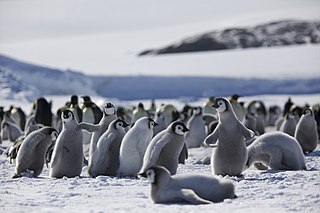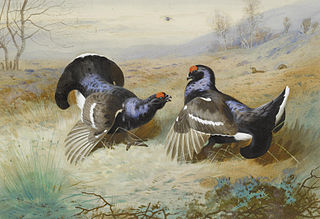Related Research Articles

Altruism is the principle and moral practice of concern for happiness of other human beings or other animals, resulting in a quality of life both material and spiritual. It is a traditional virtue in many cultures and a core aspect of various religious traditions and secular worldviews, though the concept of "others" toward whom concern should be directed can vary among cultures and religions. In an extreme case, altruism may become a synonym of selflessness, which is the opposite of selfishness.

In evolutionary biology, reciprocal altruism is a behaviour whereby an organism acts in a manner that temporarily reduces its fitness while increasing another organism's fitness, with the expectation that the other organism will act in a similar manner at a later time.

Behavioral ecology, also spelled behavioural ecology, is the study of the evolutionary basis for animal behavior due to ecological pressures. Behavioral ecology emerged from ethology after Niko Tinbergen outlined four questions to address when studying animal behaviors: What are the proximate causes, ontogeny, survival value, and phylogeny of a behavior?

The handicap principle is a hypothesis proposed by Amotz Zahavi to explain how evolution may lead to "honest" or reliable signalling between animals which have an obvious motivation to bluff or deceive each other. It suggests that costly signals must be reliable signals, costing the signaller something that could not be afforded by an individual with less of a particular trait. For example, in sexual selection, the theory suggests that animals of greater biological fitness signal this status through handicapping behaviour, or morphology that effectively lowers this quality. The central idea is that sexually selected traits function like conspicuous consumption, signalling the ability to afford to squander a resource. Receivers then know that the signal indicates quality, because inferior quality signallers are unable to produce such wastefully extravagant signals.

Group selection is a proposed mechanism of evolution in which natural selection acts at the level of the group, instead of at the more conventional level of the individual.

Cooperation is the process of groups of organisms working or acting together for common, mutual, or some underlying benefit, as opposed to working in competition for selfish benefit. Many animal and plant species cooperate both with other members of their own species and with members of other species.

Amotz Zahavi was an Israeli evolutionary biologist, a Professor in the Department of Zoology at Tel Aviv University, and one of the founders of the Society for the Protection of Nature in Israel. His main work concerned the evolution of signals, particularly those signals that are indicative of fitness, and their selection for "honesty".
Evolutionary game theory (EGT) is the application of game theory to evolving populations in biology. It defines a framework of contests, strategies, and analytics into which Darwinian competition can be modelled. It originated in 1973 with John Maynard Smith and George R. Price's formalisation of contests, analysed as strategies, and the mathematical criteria that can be used to predict the results of competing strategies.

Within evolutionary biology, signalling theory is a body of theoretical work examining communication between individuals, both within species and across species. The central question is when organisms with conflicting interests, such as in sexual selection, should be expected to provide honest signals rather than cheating. Mathematical models describe how signalling can contribute to an evolutionarily stable strategy.
In biology, altruism refers to behaviour by an individual that increases the fitness of another individual while decreasing the fitness of the actor. Altruism in this sense is different from the philosophical concept of altruism, in which an action would only be called "altruistic" if it was done with the conscious intention of helping another. In the behavioural sense, there is no such requirement. As such, it is not evaluated in moral terms—it is the consequences of an action for reproductive fitness that determine whether the action is considered altruistic, not the intentions, if any, with which the action is performed.

In evolution, co-operation is the process where groups of organisms work or act together for common or mutual benefits. It is commonly defined as any adaptation that has evolved, at least in part, to increase the reproductive success of the actor's social partners. For example, territorial choruses by male lions discourage intruders and are likely to benefit all contributors.

Eusociality evolved repeatedly in different orders of animals, particularly the Hymenoptera. This 'true sociality' in animals, in which sterile individuals work to further the reproductive success of others, is found in termites, ambrosia beetles, gall-dwelling aphids, thrips, marine sponge-dwelling shrimp, naked mole-rats, and the insect order Hymenoptera. The fact that eusociality has evolved so often in the Hymenoptera, but remains rare throughout the rest of the animal kingdom, has made its evolution a topic of debate among evolutionary biologists. Eusocial organisms at first appear to behave in stark contrast with simple interpretations of Darwinian evolution: passing on one's genes to the next generation, or fitness, is a central idea in evolutionary biology.
A biological ornament is a characteristic of an animal that appears to serve a decorative function rather than a utilitarian function. Many are secondary sexual characteristics, and others appear on young birds during the period when they are dependent on being fed by their parents. Ornaments are used in displays to attract mates, which may lead to the evolutionary process known as sexual selection. An animal may shake, lengthen, or spread out its ornament in order to get the attention of the opposite sex, which will in turn choose the most attractive one with which to mate. Ornaments are most often observed in males and choosing an extravagantly ornamented male benefits females because the genes that produce the ornament will be passed on to her offspring, increasing their own reproductive fitness. As Ronald Fisher noted, the male offspring will inherit the ornament while the female offspring will inherit the preference for said ornament, which can lead to a positive feedback loop known as a Fisherian runaway. These structures serve as cues to animal sexual behaviour, that is, they are sensory signals that affect mating responses. Therefore, ornamental traits are often selected by mate choice.
Microorganisms engage in a wide variety of social interactions, including cooperation. A cooperative behavior is one that benefits an individual other than the one performing the behavior. This article outlines the various forms of cooperative interactions seen in microbial systems, as well as the benefits that might have driven the evolution of these complex behaviors.

The theoretical foundations of evolutionary psychology are the general and specific scientific theories that explain the ultimate origins of psychological traits in terms of evolution. These theories originated with Charles Darwin's work, including his speculations about the evolutionary origins of social instincts in humans. Modern evolutionary psychology, however, is possible only because of advances in evolutionary theory in the 20th century.
Male reproductive alliances can best be understood within the context of traditional male-male competition, as a specific case of cooperative competition. Such cooperative behavior, however, does not necessarily result in the equal sharing of resources among cooperating individuals. Cooperation often requires that individuals decrease their own fitness to increase the fitness of another. This behavior becomes even more striking when it occurs within the context of cooperative reproduction, where individuals decrease their own reproductive fitness to improve the reproductive fitness of another.
Inclusive fitness in humans is the application of inclusive fitness theory to human social behaviour, relationships and cooperation.
Evolutionary biologists have developed various theoretical models to explain the evolution of food-sharing behavior—"the unresisted transfer of food from one food-motivated individual to another"—among humans and other animals.
Reciprocal altruism in humans refers to an individual behavior that gives benefit conditionally upon receiving a returned benefit, which draws on the economic concept – ″gains in trade″. Human reciprocal altruism would include the following behaviors : helping patients, the wounded, and the others when they are in crisis; sharing food, implement, knowledge.
Costly signaling theory in evolutionary psychology refers to uses of costly signaling theory and adaptationism in explanations for psychological traits and states. Often informed by the closely related fields of human behavioral ecology and cultural evolution, such explanations are predominantly focused on humans and emphasize the benefits of altering the perceptions of others and the need to do so in ways that are difficult to fake due to the widespread existence of adaptations which demand reliable information to avoid manipulation through dishonest signals.
References
- 1 2 3 Roberts, G. 1998. Competitive altruism: from reciprocity to the handicap principle. Proc. R. Soc. Lond., B 265: 429-430.
- 1 2 3 McNamara, J., Z. Barta, L. Fromhage, and A. Houston. 2008. The coevolution of choosiness and cooperation. Nature 451: 189-192.
- ↑ Zahavi, A. 1995. Altruism as a handicap: the limitations of kin selection and reciprocity. J. Avian Biol. 26 (1): 1-3.
- ↑ Hardy, C. & Van Vugt, M. (2006). Nice guys finish first: The competitive altruism hypothesis. Personality and Social Psychology Bulletin, 32,1402-1413
- ↑ Iredale, W., Van Vugt, M. & Dunbar, R (2008). Showing off: Male generosity as mate signal. Evolutionary Psychology.
- ↑ Lotem, A., M. Fishman, and L. Stone. 2003. From reciprocity to unconditional altruism through signaling benefits. Proc. R. Soc. Lond. B. 270: 200.
- ↑ Wright, J. 1999. Altruism as a signal - Zahavi's alternative to kin selection and reciprocity. Journal of Avian Biology 30: 109